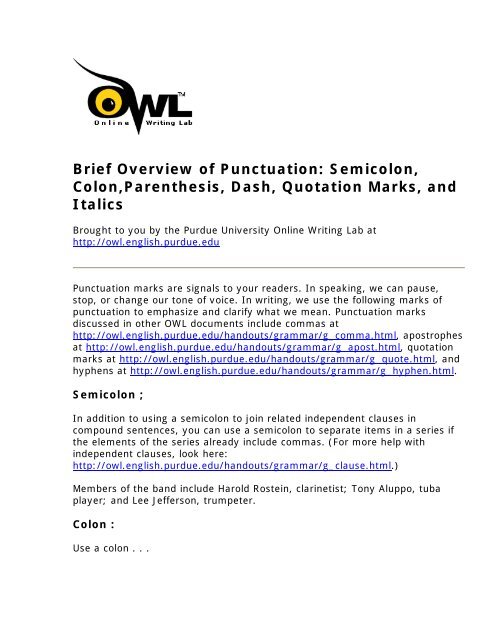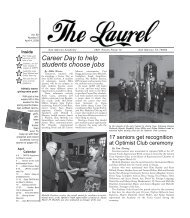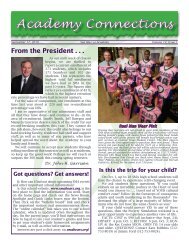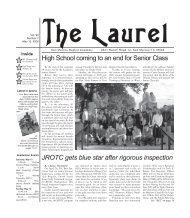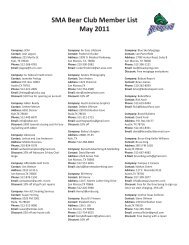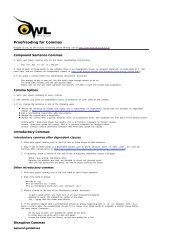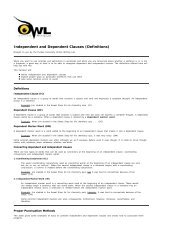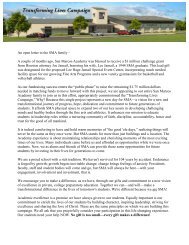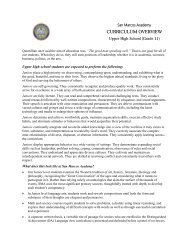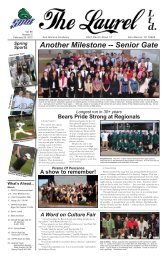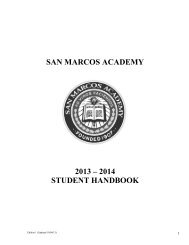Brief Overview of Punctuation: Semicolon, Colon,Parenthesis, Dash ...
Brief Overview of Punctuation: Semicolon, Colon,Parenthesis, Dash ...
Brief Overview of Punctuation: Semicolon, Colon,Parenthesis, Dash ...
You also want an ePaper? Increase the reach of your titles
YUMPU automatically turns print PDFs into web optimized ePapers that Google loves.
<strong>Brief</strong> <strong>Overview</strong> <strong>of</strong> <strong>Punctuation</strong>: <strong>Semicolon</strong>,<br />
<strong>Colon</strong>,<strong>Parenthesis</strong>, <strong>Dash</strong>, Quotation Marks, and<br />
Italics<br />
Brought to you by the Purdue University Online Writing Lab at<br />
http://owl.english.purdue.edu<br />
<strong>Punctuation</strong> marks are signals to your readers. In speaking, we can pause,<br />
stop, or change our tone <strong>of</strong> voice. In writing, we use the following marks <strong>of</strong><br />
punctuation to emphasize and clarify what we mean. <strong>Punctuation</strong> marks<br />
discussed in other OWL documents include commas at<br />
http://owl.english.purdue.edu/handouts/grammar/g_comma.html, apostrophes<br />
at http://owl.english.purdue.edu/handouts/grammar/g_apost.html, quotation<br />
marks at http://owl.english.purdue.edu/handouts/grammar/g_quote.html, and<br />
hyphens at http://owl.english.purdue.edu/handouts/grammar/g_hyphen.html.<br />
<strong>Semicolon</strong> ;<br />
In addition to using a semicolon to join related independent clauses in<br />
compound sentences, you can use a semicolon to separate items in a series if<br />
the elements <strong>of</strong> the series already include commas. (For more help with<br />
independent clauses, look here:<br />
http://owl.english.purdue.edu/handouts/grammar/g_clause.html.)<br />
Members <strong>of</strong> the band include Harold Rostein, clarinetist; Tony Aluppo, tuba<br />
player; and Lee Jefferson, trumpeter.<br />
<strong>Colon</strong> :<br />
Use a colon . . .
in the following situations:<br />
after a complete statement in<br />
order to introduce one or more<br />
directly related ideas, such as a<br />
series <strong>of</strong> directions, a list, or a<br />
quotation or other comment<br />
illustrating or explaining the<br />
statement.<br />
in a business letter greeting.<br />
between the hour and minutes<br />
in time notation.<br />
between chapter and verse in<br />
biblical references.<br />
for example:<br />
The daily newspaper contains<br />
four sections: news, sports,<br />
entertainment, and classified<br />
ads.<br />
The strategies <strong>of</strong> corporatist<br />
industrial unionism have proven<br />
ineffective: compromises and<br />
concessions have left labor in a<br />
weakened position in the new<br />
"flexible" economy.<br />
Dear Ms. Winstead:<br />
5:30 p.m.<br />
Genesis 1:18<br />
Parentheses ()<br />
Parentheses are occasionally and sparingly used for extra, nonessential<br />
material included in a sentence. For example, dates, sources, or ideas that are<br />
subordinate or tangential to the rest <strong>of</strong> the sentence are set apart in<br />
parentheses. Parentheses always appear in pairs.<br />
Before arriving at the station, the old train (someone said it was a relic <strong>of</strong><br />
frontier days) caught fire.<br />
<strong>Dash</strong> --<br />
Use a dash (represented on a typewriter, a computer with no dashes in the<br />
type font, or in a handwritten document by a pair <strong>of</strong> hyphens with no spaces) .<br />
. .<br />
in the following situations:<br />
to emphasize a point or to set<br />
<strong>of</strong>f an explanatory comment;<br />
but don't overuse dashes, or<br />
they will lose their impact.<br />
for example:<br />
To some <strong>of</strong> you, my proposals<br />
may seem radical--even<br />
revolutionary.<br />
In terms <strong>of</strong> public legitimation--
for an appositive phrase that<br />
already includes commas.<br />
that is, in terms <strong>of</strong> garnering<br />
support from state legislators,<br />
parents, donors, and university<br />
administrators--English<br />
departments are primarily<br />
places where advanced literacy<br />
is taught.<br />
The boys--Jim, John, and Jeff--<br />
left the party early.<br />
For more help with appositives, look here:<br />
http://owl.english.purdue.edu/handouts/grammar/g_appos.html<br />
As you can see, dashes function in some ways like parentheses (used in pairs<br />
to set <strong>of</strong>f a comment within a larger sentence) and in some ways like colons<br />
(used to introduce material illustrating or emphasizing the immediately<br />
preceding statement). But comments set <strong>of</strong>f with a pair <strong>of</strong> dashes appear less<br />
subordinate to the main sentence than do comments in parentheses. And<br />
material introduced after a single dash may be more emphatic and may serve a<br />
greater variety <strong>of</strong> rhetorical purposes than material introduced with a colon.<br />
Quotation Marks " "<br />
Use quotation marks . . .<br />
in the following situations:<br />
to enclose direct quotations.<br />
Note that commas and periods<br />
go inside the closing quotation<br />
mark in conventional American<br />
usage; colons and semicolons<br />
go outside; and placement <strong>of</strong><br />
question and exclamation marks<br />
depends on the situation (see<br />
our quotation marks document).<br />
to indicate words used<br />
ironically, with reservations, or<br />
in some unusual way; but don't<br />
overuse quotation marks in this<br />
sense, or they will lose their<br />
impact.<br />
for example:<br />
He asked, "Will you be there?"<br />
"Yes," I answered, "I'll look for<br />
you in the foyer."<br />
History is stained with blood<br />
spilled in the name <strong>of</strong><br />
"civilization."
For more information on writing research papers and using quotations, see our<br />
workshop on writing research papers here<br />
http://owl.english.purdue.edu/workshops/hypertext/ResearchW/index.html.<br />
Underlining and Italics<br />
Underlining and italics are not really punctuation, but they are significant<br />
textual effects used conventionally in a variety <strong>of</strong> situations. Before<br />
computerized word-processing was widely available, writers would underline<br />
certain terms in handwritten or manually typed pages, and the underlining<br />
would be replaced by italics in the published version. Since word processing<br />
today allows many options for font faces and textual effects, it is generally<br />
recommended that you choose either underlining or italics and use it<br />
consistently throughout a given document as needed. Because academic<br />
papers are manuscripts and not final publications and because italics are not<br />
always easily recognized with some fonts, many instructors prefer underlining<br />
over italics for course papers. Whichever you choose, italics or underlining<br />
should be used . . .<br />
in the following situations:<br />
to indicate titles <strong>of</strong> complete or<br />
major works such as<br />
magazines, books, newspapers,<br />
academic journals, films,<br />
television programs, long<br />
poems, plays <strong>of</strong> three or more<br />
acts<br />
foreign words that are not<br />
commonly used in English<br />
words used as words<br />
themselves<br />
words or phrases that you wish<br />
to emphasize<br />
for example:<br />
Faulkner's last novel was The<br />
Reivers.<br />
The Simpsons <strong>of</strong>fers hilarious<br />
parodies <strong>of</strong> American culture<br />
and family life.<br />
Wearing blue jeans is de rigueur<br />
for most college students.<br />
The English word nuance comes<br />
from a Middle French word<br />
meaning "shades <strong>of</strong> color."<br />
The very founding principles <strong>of</strong><br />
our nation are at stake!<br />
After reviewing this handout, you can try the Purdue OWL exercise on<br />
semicolons, parentheses, dashes, quotation marks and italics (and then check<br />
your answers). You can find it here:<br />
http://owl.english.purdue.edu/handouts/grammar/g_overvwEX1.html
The following information must remain intact on every handout printed for distribution.<br />
This page is located at http://owl.english.purdue.edu/handouts/print/grammar/g_overvw.html<br />
Copyright ©1995-2004 by OWL at Purdue University and Purdue University. All rights<br />
reserved.<br />
Use <strong>of</strong> this site, including printing and distributing our handouts, constitutes acceptance <strong>of</strong> our<br />
terms and conditions <strong>of</strong> fair use, available at<br />
http://owl.english.purdue.edu/lab/fairuse.html.<br />
To contact OWL, please visit our contact information page at<br />
http://owl.english.purdue.edu/lab/contact.html to find the right person to call or email.


